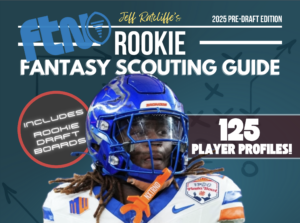
Each week, I’ll review my single-entry NFL DFS lineup, as well as a couple others. I will also track success rates throughout the season. The criteria for the other lineups to make the article (and tracking) will be over 10% of my overall investment. This week, that includes:
- Single-entry lineup
The goal here is to hold myself accountable for the decisions I make while also helping to provide a blueprint for long-term success in GPPs.
Throughout the year, I’ll emphasize the top 10% and top 1% hit rates. While profit/loss is at the mercy of significant variance at the top of tournaments, these hit rates stabilize much faster and can therefore paint a stronger picture of our performance.
My single-entry this week was awful, but I had a lot of successful MME lineups thanks to strong performances from value RBs such as:
This got me thinking — for years, NFL DFS has been largely about jamming in expensive, high-volume and ceiling RBs alongside value WRs whose ceilings are higher than similarly priced RBs due to the volatility of WR performance. Perhaps, however, we should be reversing this build. In lieu of my typical breakdown and analysis of my process, let’s thoroughly explore this thought.
The Single-Entry
This lineup was an absolute disaster, and notice the fact that it followed the old blueprint — three stud RBs, a cheap passing stack, and a chalk, cheap WR. Rather than discuss why this lineup failed, let’s look at some reasons why we may want to get ahead of the curve by flipping the build-structure in weeks to come.
Argument 1 – WRs now have the highest ceiling
Take a look at this week’s top five WRs vs. the top five RBs:
Last week, the top four scorers were Cooper Kupp, Ja’Marr Chase, A.J. Brown and Mike Evans.
Argument 2 – The value RBs are getting no ownership, yet performing
Some examples from this week (that weren’t random flukes):
The reason for lower RB ceilings is also the reason for so many spike performances from cheaper RBs — RB volume is more spread out and unpredictable than ever. Here’s the thing — RB ownership will continue to follow projections more closely than any other position, but these cheaper backs with uncertain volume have real ceilings due to multiple paths to greater-than-expected volume (and TD equity!). So we get the following:
- Underowned RBs in relation to their ceiling
- Smaller gap between value performance and stud RBs since the RB ceilings have come down
- Automatic diversification through a different build type. In other words, in a generic week, you could hypothetically fit Davante Adams and Cooper Kupp together at 30% each, yet be one of very few to have both.
Argument 3 – RB chalk is busting!
The two biggest chalk-busts of the season have been RBs — Kareem Hunt two weeks ago, D’Andre Swift this week. I urge you to look back at your contests from the last few weeks and scroll through RB performance, noting the relationship between ownership and score — it’s been almost completely independent.
Argument 4 – Automatic diversification in passing stacks
Often, these cheaper backs are receiving-dependent. There’s been talk of double stacks and bringbacks being overused lately (in large part because the ceiling games are coming from WRs more often than not), yet particularly in single entries, we don’t want to sacrifice correlation. Enter the QB/RB/WR double stack where the running back is a contrarian value who would benefit from increased pass volume as a whole.
This strategy would allow you to chase one-off ceiling performances from multiple WRs without having to sacrifice the correlation that double stacks provide, lowering the number of things you need to be right about for your lineup to hit.
Takeaways
I’m really excited by this thought. Obviously, my single-entry performance so far this season suggests I could use a change in strategy, and I believe this is a great way to do it. The lower RB ceilings mean we’re also less likely to get penalized by these decisions, so long as we hit on a WR or two.
Consider this: While it was impossible to survive the D’Andre Swift and Nick Chubb busts because no cheap enough WRs or TEs did enough to make up for them, a miss or two on cheap RBs could have been salvaged by the chalk trio of Cooper Kupp, Chris Godwin and A.J. Brown.
Check out this potential lineup with a complete whiff on David Johnson at $4,200, as well as mediocre performances from chalk I loved in Tee Higgins, Dallas Goedert, and WAS DST:
That’s 170.1 with a near zero at RB. Michael Carter’s ceiling performance instead of Jonathan Taylor and/or Michael Pittman instead of Tee Higgins, and you’ve got yourself a takedown. Like I said: I can’t wait to try out this strategy on Sunday.












































 New York Jets
New York Jets  New England Patriots
New England Patriots  Miami Dolphins
Miami Dolphins  Buffalo Bills
Buffalo Bills  Pittsburgh Steelers
Pittsburgh Steelers  Cleveland Browns
Cleveland Browns  Cincinnati Bengals
Cincinnati Bengals  Baltimore Ravens
Baltimore Ravens  Tennessee Titans
Tennessee Titans  Jacksonville Jaguars
Jacksonville Jaguars  Indianapolis Colts
Indianapolis Colts  Houston Texans
Houston Texans  Las Vegas Raiders
Las Vegas Raiders  Los Angeles Chargers
Los Angeles Chargers  Kansas City Chiefs
Kansas City Chiefs  Denver Broncos
Denver Broncos  Washington Commanders
Washington Commanders  Philadelphia Eagles
Philadelphia Eagles  New York Giants
New York Giants  Dallas Cowboys
Dallas Cowboys  Minnesota Vikings
Minnesota Vikings  Green Bay Packers
Green Bay Packers  Detroit Lions
Detroit Lions  Chicago Bears
Chicago Bears  Tampa Bay Buccaneers
Tampa Bay Buccaneers  New Orleans Saints
New Orleans Saints  Carolina Panthers
Carolina Panthers  Atlanta Falcons
Atlanta Falcons  San Francisco 49ers
San Francisco 49ers  Seattle Seahawks
Seattle Seahawks  Los Angeles Rams
Los Angeles Rams  Arizona Cardinals
Arizona Cardinals 








 Boston Celtics
Boston Celtics  Brooklyn Nets
Brooklyn Nets  Philadelphia 76ers
Philadelphia 76ers  New York Knicks
New York Knicks  Toronto Raptors
Toronto Raptors  Chicago Bulls
Chicago Bulls  Detroit Pistons
Detroit Pistons  Milwaukee Bucks
Milwaukee Bucks  Cleveland Cavaliers
Cleveland Cavaliers  Indiana Pacers
Indiana Pacers  Orlando Magic
Orlando Magic  Atlanta Hawks
Atlanta Hawks  Charlotte Hornets
Charlotte Hornets  Miami Heat
Miami Heat  Washington Wizards
Washington Wizards  Denver Nuggets
Denver Nuggets  Minnesota Timberwolves
Minnesota Timberwolves  Oklahoma City Thunder
Oklahoma City Thunder  Portland Trail Blazers
Portland Trail Blazers  Utah Jazz
Utah Jazz  LA Clippers
LA Clippers  Golden State Warriors
Golden State Warriors  Los Angeles Lakers
Los Angeles Lakers  Phoenix Suns
Phoenix Suns  Sacramento Kings
Sacramento Kings  Dallas Mavericks
Dallas Mavericks  Houston Rockets
Houston Rockets  Memphis Grizzlies
Memphis Grizzlies  New Orleans Pelicans
New Orleans Pelicans  San Antonio Spurs
San Antonio Spurs 










